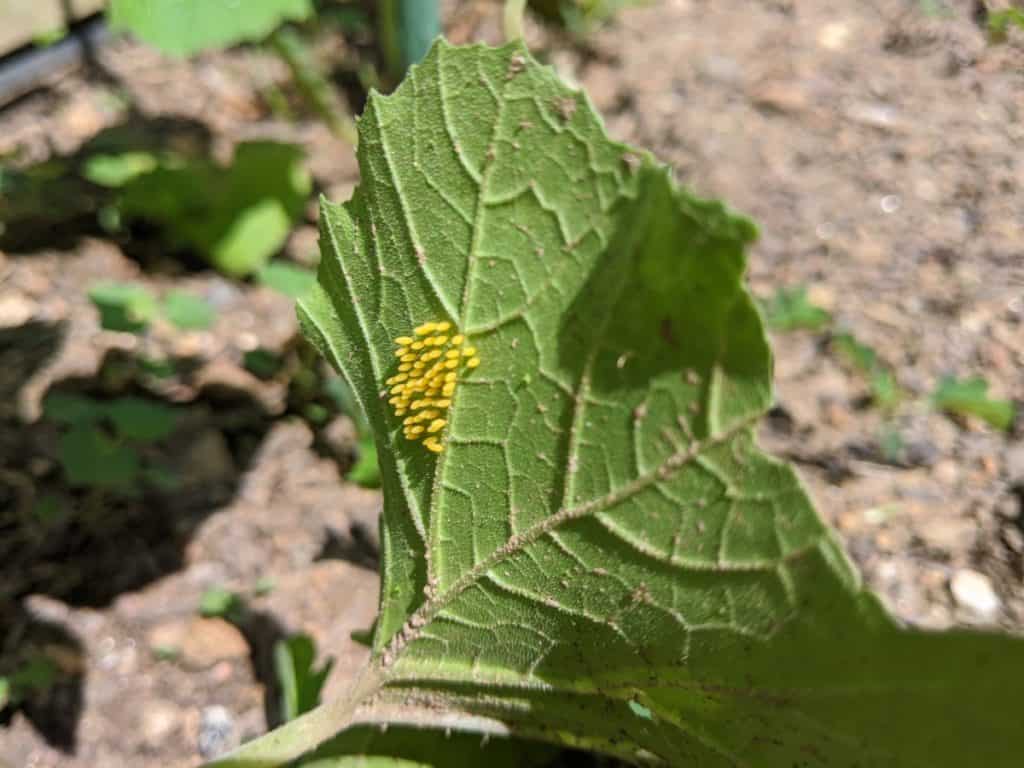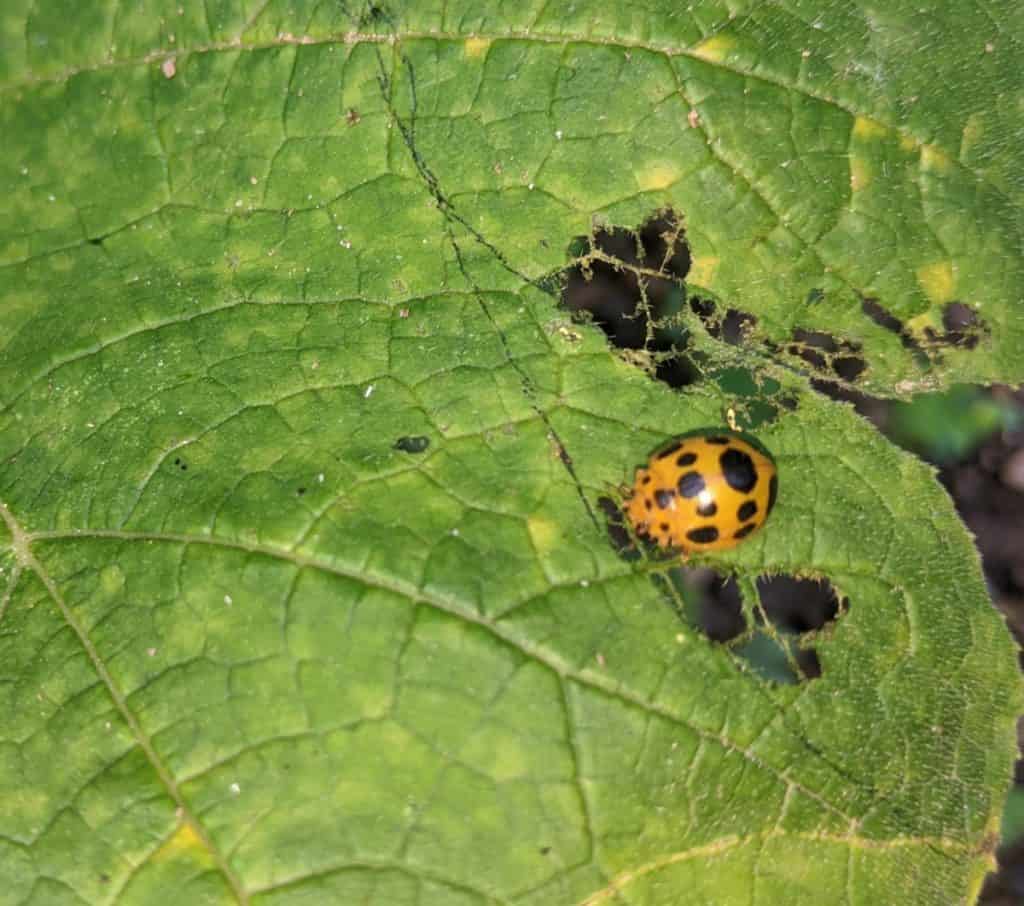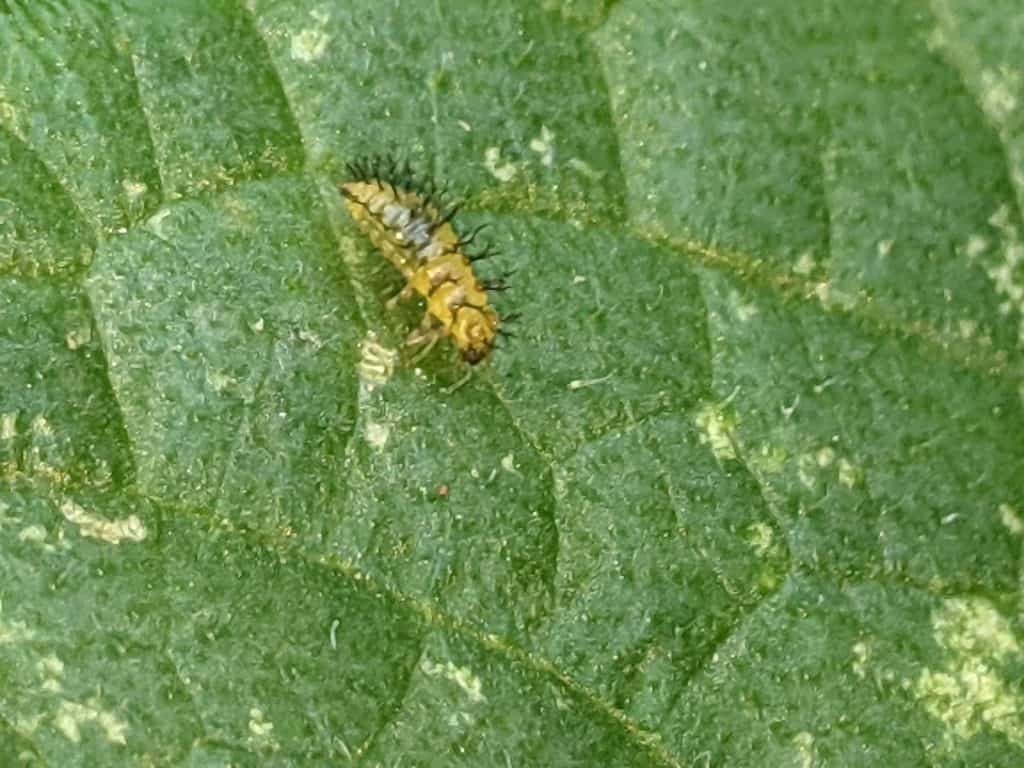If you grow plants from the squash family on the east coast, chances are you’ve run into problems with the small orange lady beetle and wondered how to get rid of it. This insect is known as a squash beetle (Epilachna Borealis).
Don’t confuse it with the most common red ladybug in North America the Asian ladybug, (Harmonia axyridis). These beetles are beneficial to your garden by eating aphids and other garden pests.
I remember when I first saw this small orange bug on my squash plants years ago and thought they were one of the harmless beneficial insects. A week or so later I knew I had made a bad mistake.
This mistake of not removing the squash beetles quickly ruined some of my squash plants that gardening season.
In this article, we will go over the methods of how to get rid of squash lady beetles, their eggs, and their yellow fuzzy larvae during the growing season.

How do You Get Rid of Squash Lady Beetles Quickly?
The best non-toxic way to quickly get rid of squash lady beetles (Epilachna Borealis)is to remove them by hand. When you touch the Squash lady beetle it will release itself from the leaf falling to the ground. The beetle pretends to be dead and doesn’t move.
You can take 2 pieces of hard plastic and crush the beetle or the yellow fuzzy larvae while it’s still on the leaf. This way it will not be able to fall in the ground and get lost in the soil.
If you don’t wish to kill the beetle while it’s directly on the plant then you can use an alternative method.
Handpick the Squash Beetle
This method is to pick them off by hand and put them into a bucket of soapy water with 2 tablespoons of dish soap. You can remove the squash lady beetle larvae the same way.
The squash lady beetle eggs seen below must also be removed. You will find them on the underside of the leaves and they can be removed by scraping them off with a piece of hard plastic like an old credit card.

5 More Ways to Get Rid of Squash Beetles
Neem Oil: An additional way to get rid of squash lady beetles is to spray the leaves with neem oil. Make sure you spray the underside of the leaves as well but avoid the flowers of the plants. If you do spray I would suggest removing everything by hand first and then spraying the plants.
Insecticidal soaps: You can coat the underside and tops of the leaves with insecticidal soaps. This should make them unpalatable to the Squash beetle garden pest. A reminder I would remove them all by hand first dispose of them and then spray the plants.
Seven dust: The posion Seven dust will kill squash beetles. The problem is it can harm beneficial insects such as bees, and other pollinating insects. If you have an organic vegetable garden you should try one of the other methods first.
Crop rotation: Plant your squash and the related family of plants in a new area of your garden each year. Planting in the same spot only once every three years.
Remove crop and plant debris: Squash beetles like to overwinter in leaf and dead crop debris. The return to your garden around the June time frame.
If you clean up any dead leaves and plant debris this will help control the squash beetle population. Do not put the debris in your compost pile.
Does diatomaceous earth kill squash beetles?
In my experience, diatomaceous earth was ineffective in getting rid of a bad infestation of squash lady beetles. I also had to reapply it whenever it rained. I would stick to other methods for removing squash beetles.

What Does The Squash Beetle Eat?
The squash beetle feeds upon the leaves of cucurbits. The other species, and a close relative of the squash beetle the Mexican bean beetle (Epilachna varivestis), feeds on bean plants.
I have had trouble with these pests eating my cucumber, zucchini, squash, and pumpkin plants to name a few. The beetle is also known to eat the leaf tissues out of the leaves of gourds, watermelons, and cantaloupes.
The squash beetle can devastate a plant in a few short weeks so it’s important to start controlling the pest early with various methods.
Squash beetles overwinter on various crop debris, and leaf litter near the edge of fields. So remove cucurbits crop debris and burn it if you can.

Where do Squash Beetles Come From?
The squash lady beetle is native to the eastern part of the United States. The adult feeds on the entire leaves tissue of the plants except for the leaf veins. The squash beetle yellow fuzzy larvae only feed on the underside of leaves.
The yellow fuzzy larvae and adults start feeding by producing a trench around the leaf tissue that they plan to eat. They do this to reduce a plant’s ability to excrete chemicals and sap that would hinder the feeding of plant tissues.
Squash Lady Beetle Life Cycle
Squash lady beetles overwinter on leaf litter or crop debris on the edge of fields. When June arrives the beetles move back into vegetable gardens and began feeding on squash, cucumber, zucchini, and other cucurbit crops.
The squash lady beetle then deposits eggs on plants in June and the larvae start to mature over the next three weeks. After pupating they hatch and began feeding on the leaf tissues.
This takes close to 5 weeks. The new generation of adults emerge and feed until they leave at the end of September to overwinter in debris.
Conclusion
Getting rid of squash lady beetles quickly is a must once you identify them. If you don’t they will become a garden pest that can devastate your garden.
Try these tips and hopefully you will put this garden pest in your rearview mirror. Happy harvesting.
